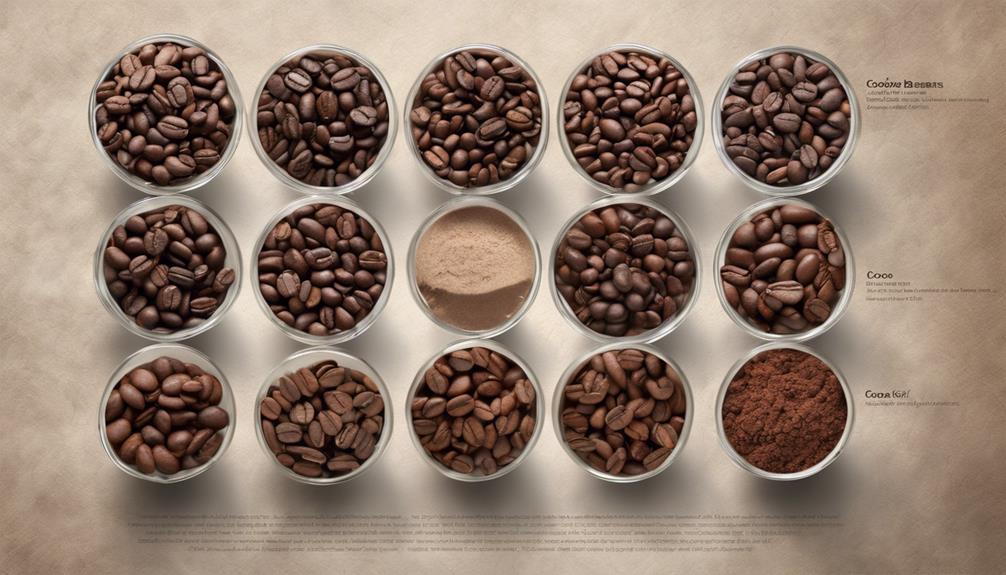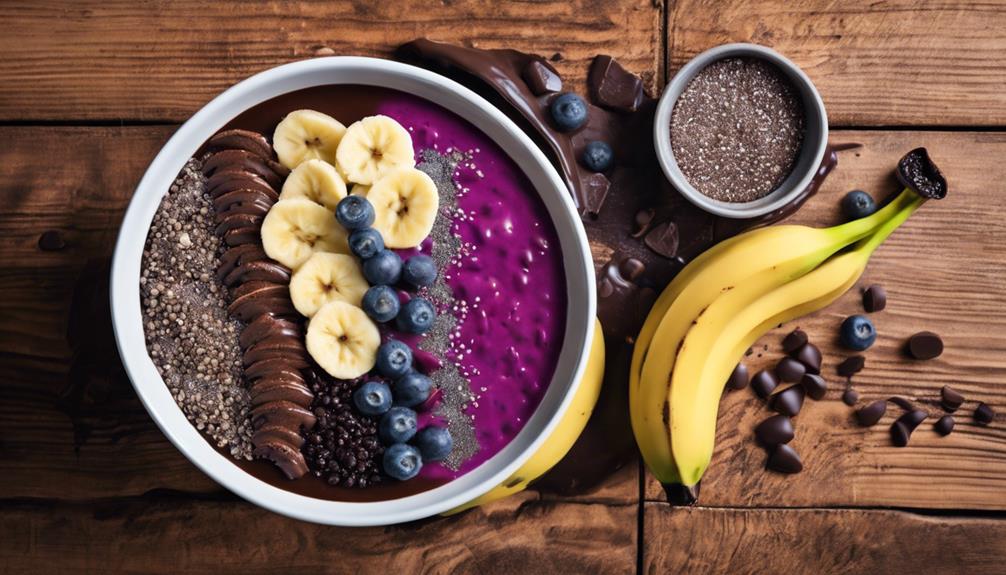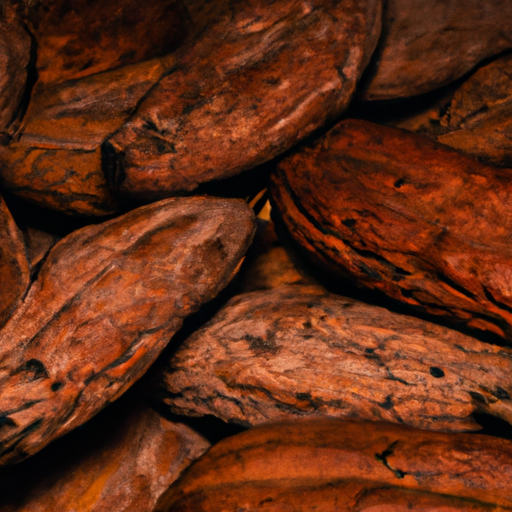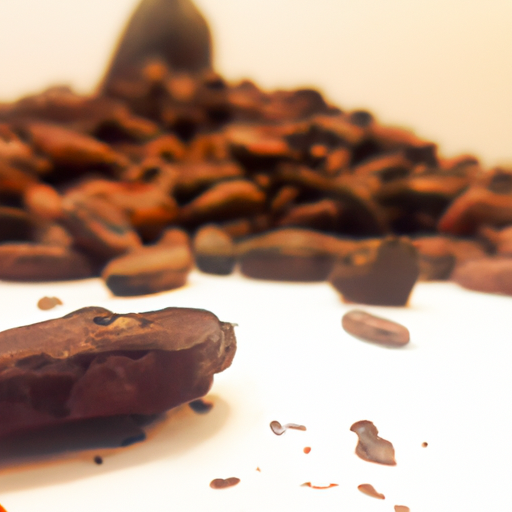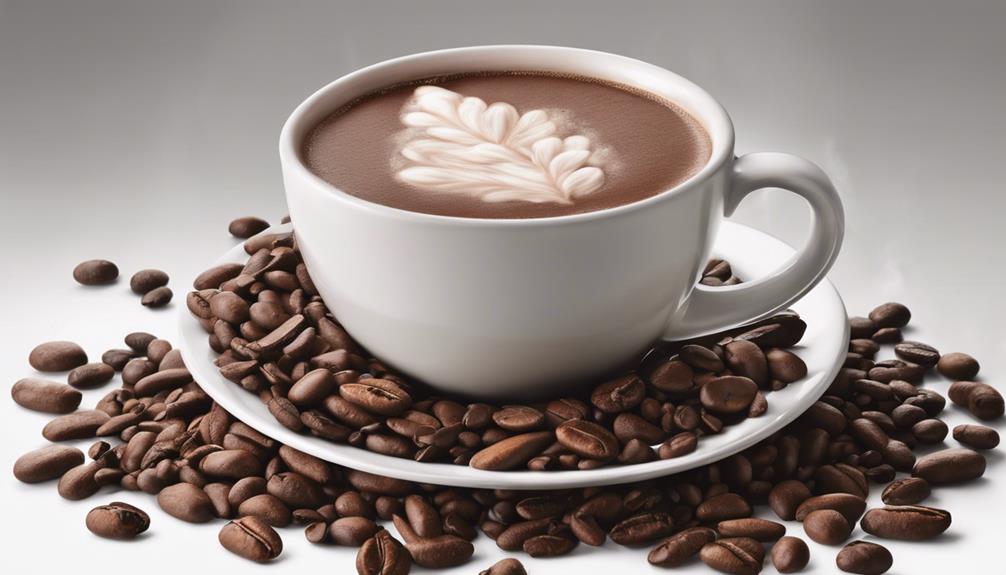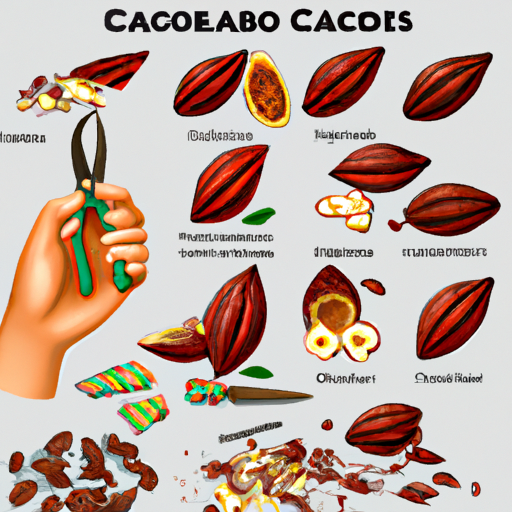When comparing coffee beans and cocoa beans, there are several key differences to note. Coffee beans provide a deep, earthy flavor with acidity, bitterness, and sweetness, while cocoa beans have a complex, rich taste with hints of bitterness, fruitiness, and nuttiness. In terms of caffeine content, coffee beans contain about 95 mg per cup compared to cocoa beans’ 12 mg, providing a quick energy boost. Cocoa beans have a higher fat content of around 50% compared to coffee beans’ 14%, impacting texture and flavor profiles significantly. Understanding these differences will enhance your appreciation for the various uses and characteristics of these beloved beans.
Key Takeaways
- Coffee beans have higher caffeine content than cocoa beans.
- Cocoa beans contain significantly more fat compared to coffee beans.
- Coffee beans are typically grown at higher altitudes than cocoa beans.
- Cocoa beans are rich in antioxidants, while coffee beans provide a quick energy boost.
- Cocoa farming promotes biodiversity, while coffee production can lead to deforestation.
Flavor Profiles
When comparing the flavor profiles of coffee beans and cocoa beans, one can discern distinct characteristics that set them apart with regards to depth and complexity. Coffee beans offer a deep and earthy flavor with varying notes of acidity, bitterness, and sweetness.
On the other hand, cocoa beans present a more intricate and rich flavor profile with hints of bitterness, fruitiness, and nuttiness. Roasting plays an important role in shaping these flavors.
While roasting coffee beans brings out caramelization and acidity notes, roasting cocoa beans enhances flavors like fruity, floral, and earthy undertones while reducing bitterness. Both coffee and cocoa beans have the potential to develop subtle nuances and complexities in flavor through precise roasting techniques.
Understanding these differences in flavor profiles between coffee and cocoa beans can enrich our appreciation for the diverse tastes that these beans offer, making each sip and bite a unique sensory experience.
Caffeine Content
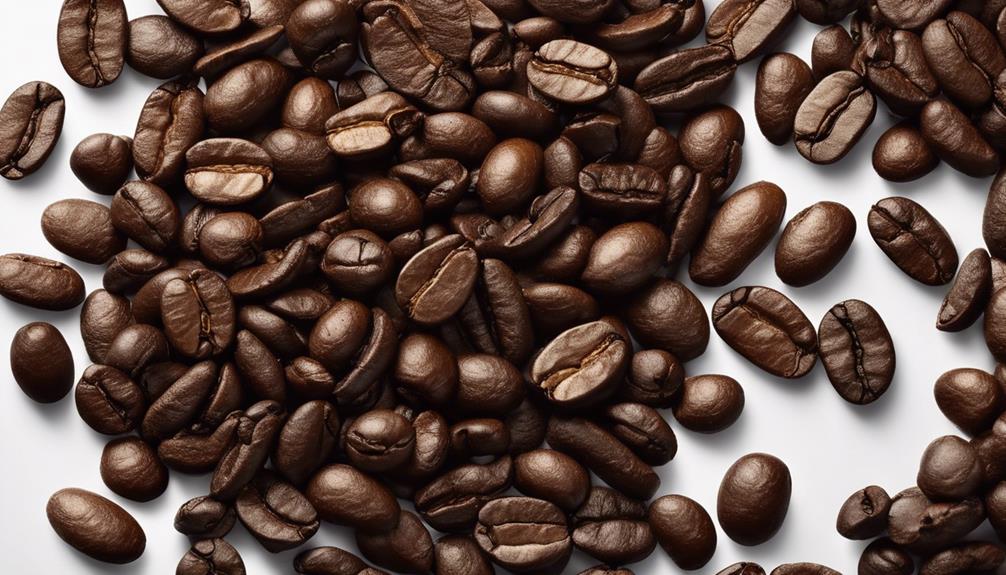
Coffee beans have a much higher caffeine content compared to cocoa beans. When you sip on a cup of coffee, you're getting about 95 mg of caffeine, while a piece of dark chocolate only contains around 12 mg.
Here are some key points to ponder about caffeine content:
- Coffee beans pack a punch: With their higher caffeine concentration, coffee beans can give you a quick jolt of energy, making you feel more alert and focused.
- Cocoa beans offer a gentler kick: The theobromine in cocoa beans provides a milder stimulant effect, leading to a more sustained and gentle energy release.
- Variability in caffeine: The caffeine in coffee beans can vary based on factors like the type of bean, how it's roasted, and how it's brewed, affecting its stimulating effects.
- Preference for different effects: Some people prefer coffee for its quick and strong boost, while others opt for cocoa for a more gradual and subtle energizing experience.
Understanding the caffeine content in coffee and cocoa beans can help you choose the right pick-me-up for your day!
Fat Content
With a significantly higher fat content of about 50%, cocoa beans distinguish themselves from coffee beans in their composition. This fat content plays a significant role in the mouthfeel and flavor complexity of chocolate products.
When cocoa beans are processed into chocolate, this fat, known as cocoa butter, contributes to the rich and creamy texture that chocolate lovers enjoy. On the other hand, coffee beans contain only around 14% fat, making them better suited for brewing coffee where a lighter and less oily texture is desired in the final cup.
The difference in fat content between cocoa and coffee beans directly impacts the flavor profile of the end products. While cocoa beans with higher fat content create a velvety and indulgent experience in chocolate, coffee beans with lower fat content allow for a more distinct and nuanced flavor profile in brewed coffee.
Understanding the fat content variations between these beans is essential for achieving the desired taste and texture in your favorite chocolate or coffee treats.
Processing Methods
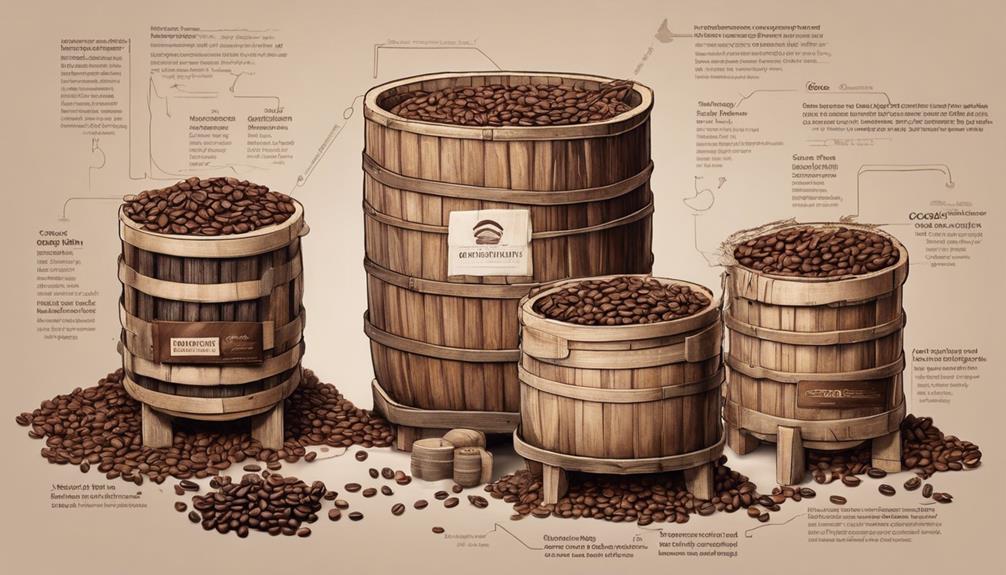
Using traditional wooden boxes, cocoa beans kickstart their processing journey with an important step of fermentation. During this vital stage, the beans are carefully inspected for ripeness and quality, ensuring a high standard for further processing.
Here are some key differences between the processing methods of coffee beans and cocoa beans:
- Coffee Beans: Processed using methods like washed, honey, and natural to remove flesh and reveal the bean.
- Cocoa Beans: Begin with fermentation in wooden boxes, with a focus on quality during harvesting.
- Coffee Beans: Typically undergo water, fermentation, and drying techniques for fruit removal.
- Cocoa Beans: Fermented in wooden boxes, with quality checks done promptly after harvesting.
Understanding these distinct processing methods sheds light on the meticulous care and attention to detail involved in the journey from bean to cup for both coffee and cocoa enthusiasts.
Brewing Techniques
When it comes to brewing coffee, the method used can greatly impact the final taste and texture of the drink.
From drip coffee to espresso, each technique offers a unique way to extract the flavors from the coffee beans.
Understanding these brewing methods is essential in creating a perfect cup of coffee tailored to your preferences.
Coffee Brewing Methods
Exploring various coffee brewing methods reveals the artistry and science behind extracting unique flavor profiles from coffee beans. Here are some popular methods to brew your perfect cup:
- Espresso: Utilizing high pressure, espresso extracts intense flavors quickly from finely ground coffee beans.
- French press: This method involves steeping coarse coffee grounds in hot water before pressing them down with a plunger, resulting in a rich and full-bodied brew.
- Pour-over: By pouring hot water over coffee grounds in a slow and steady stream, this method allows for a more controlled extraction of flavors, producing a clean and bright cup.
- Cold brew: Brewing coffee with cold water over an extended period results in a smooth, low-acidic, and invigorating coffee concentrate perfect for iced coffee or mixing with milk.
Cocoa Preparation Techniques
Brewing cocoa involves a distinct process of grinding roasted cocoa beans and combining them with hot water or milk to create a rich and flavorful cocoa beverage. Different techniques like Dutch processing can alter the flavor by reducing acidity and enhancing taste.
Cocoa beans are versatile and used in making various chocolate products, hot cocoa drinks, and desserts. To create the perfect cocoa, adjust the cocoa powder, sweeteners, and milk to suit your taste preferences. Personalize your cocoa experience by adding spices, flavors, or whipped cream.
Cocoa preparation techniques offer a range of options for creating a customized and delicious cocoa beverage.
Flavor Extraction Processes
Using various brewing techniques, I extract the rich flavors of coffee from the beans to create a diverse range of aromatic and satisfying beverages.
- Brewing coffee involves extracting flavors through methods like drip, French press, espresso, Aeropress, and cold brew.
- Different brewing techniques impact the taste, aroma, and strength of the coffee.
- Water temperature, grind size, brewing time, and pressure are essential factors in flavor extraction.
The roasting and grinding process of cocoa beans influences the final flavor profile of chocolate.
Culinary Uses
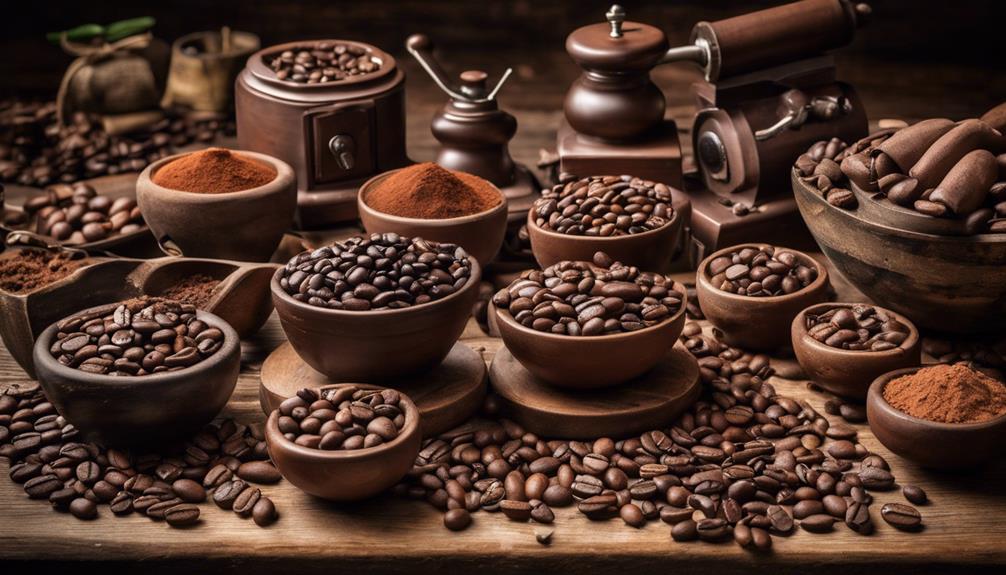
When it comes to culinary uses, both coffee and cocoa beans offer distinct flavor profiles that can elevate a wide range of dishes.
Coffee beans are commonly utilized in desserts like tiramisu and coffee-flavored cakes to impart a bold and rich taste.
On the other hand, cocoa beans are transformed into cocoa powder for baking or making velvety hot chocolate, adding a decadent chocolate essence to recipes.
Flavor Profiles
Exploring the culinary world, one can immediately distinguish the distinctive flavor profiles of coffee beans and cocoa beans.
- Coffee Beans: Offer a deep and earthy flavor profile with notes of caramel, nuts, and fruits, making them perfect for brewing hot or cold coffee beverages.
- Cocoa Beans: Provide a rich and complex flavor profile with hints of bitterness, sweetness, and fruity undertones, ideal for creating various types of chocolate products.
When enjoying coffee, you may savor the caramel notes and fruity undertones, while cocoa beans bring a mix of bitterness and sweetness to your palate. These flavor profiles play a pivotal role in determining the culinary uses of both beans, offering a wide array of delicious possibilities for coffee and chocolate lovers alike.
Cooking Applications
Incorporating coffee and cocoa beans into various dishes enhances their flavors and adds depth to culinary creations.
Coffee beans are often used in beverages like brewed coffee, espresso, and cold brew, providing a rich and aromatic experience. On the other hand, cocoa beans shine in chocolate products such as dark chocolate, milk chocolate, and hot chocolate, delivering a luscious cocoa taste.
When it comes to cooking applications, coffee beans can elevate desserts, marinades, and rubs with their robust essence, while cocoa beans excel in baking recipes for cookies, brownies, cakes, and truffles, offering a decadent chocolate flavor.
Both beans can also be ground and used as a seasoning in savory dishes like chili, mole sauce, and spice rubs for meats, enhancing the overall taste profile.
Health Benefits
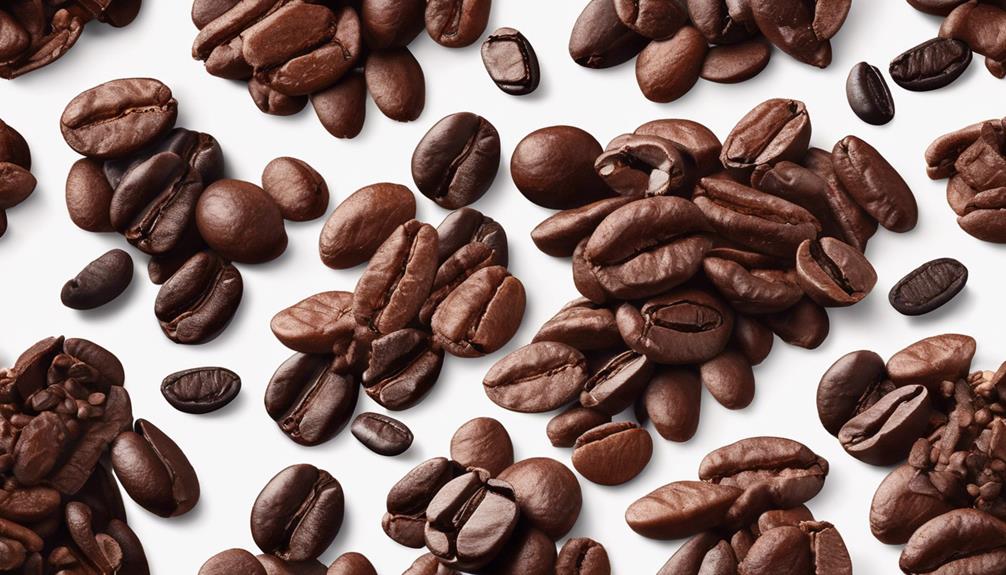
Among the various benefits of both coffee beans and cocoa beans, their distinct health properties play a significant role in enhancing overall well-being. When considering health benefits, it's crucial to note that both coffee and cocoa beans offer unique advantages:
- Antioxidants: Cocoa beans are rich in antioxidants, which help combat oxidative stress and promote overall health.
- Caffeine: Coffee beans provide a quick energy boost, supporting brain function and alertness.
- Theobromine: Cocoa beans contain theobromine, which can enhance processing speed and memory.
- Brain Health: Both coffee and cocoa beans contribute to brain health, with caffeine from coffee beans and theobromine from cocoa beans playing key roles.
Understanding the specific health benefits of each bean can aid in making informed choices to support a balanced and healthy lifestyle. So, whether you're looking for a quick pick-me-up or a boost in memory, incorporating both coffee and cocoa beans into your diet can offer a range of health advantages.
Environmental Impact
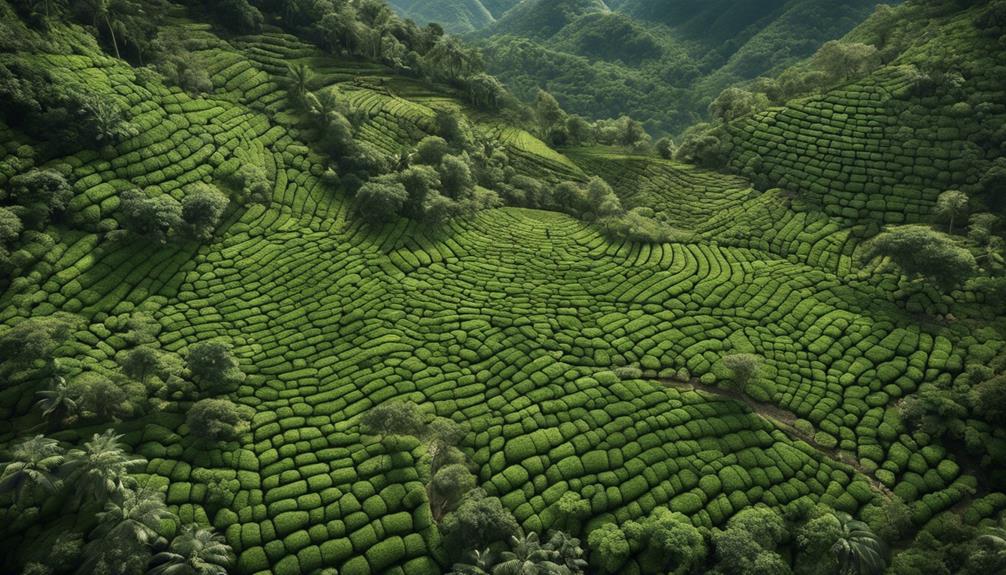
Cocoa cultivation demonstrates a more eco-friendly approach compared to coffee farming due to its promotion of biodiversity and reduced need for chemical inputs. Unlike coffee, which often leads to deforestation in tropical regions, cacao farming supports biodiversity by growing under the canopy of taller trees. This shade-grown method not only provides a habitat for various plant and animal species but also reduces the reliance on agrochemicals.
In contrast, coffee production requires more water and contributes to soil erosion and water pollution due to agrochemical use. The environmental impact of these two crops varies greatly, with cacao showing a more sustainable farming practice. By choosing products that support shade-grown and biodiversity-friendly practices like cacao, we can help protect our ecosystems and reduce the negative effects of agriculture on the environment.
Growing Conditions
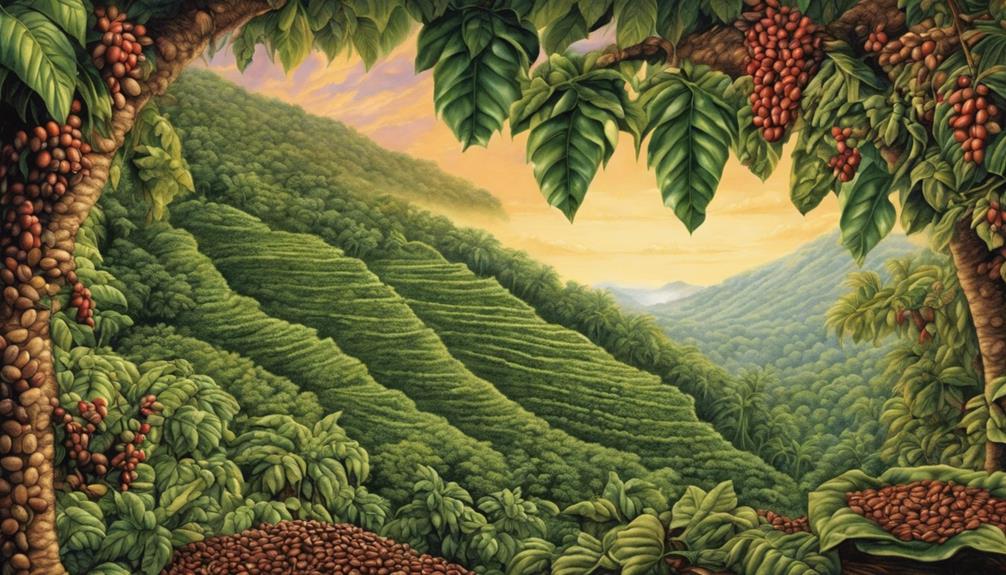
Cocoa beans and coffee beans have distinct preferences when it comes to growing conditions. Cocoa beans thrive in low-lying forest areas, while coffee beans prefer higher altitudes.
Understanding these climate and soil requirements is essential for successful cultivation of these two beloved beans.
Climate Impact on Growth
When considering the ideal growth conditions for coffee and cacao beans, it becomes apparent that their preferences for climate and elevation play a significant role in shaping their distinct characteristics and flavors.
Here are some key differences in how climate impacts the growth of these beans:
- Cacao prefers low-lying forest conditions, while coffee thrives at higher altitudes in the tropical belt.
- Quality of both coffee and cacao depends on their growing conditions, varietal, and post-harvest processing.
- Coffee beans are typically grown in warm places at higher altitudes, while cacao beans are cultivated in the Amazon rainforests of South America.
- Both coffee and cacao have distinct preferences regarding climate and elevation for the best growth and quality.
Soil Requirements for Plants
Considering the specific soil requirements for best growth, it becomes evident that both coffee and cacao plants exhibit distinct preferences and adaptations to varying soil conditions. Cacao plants thrive in well-drained, fertile soil with high organic matter content, while coffee plants are versatile and can adapt to different soil types, including volcanic and loamy soils.
Coffee plants prefer acidic soil with a pH range of 6.0 to 6.5, whereas cacao plants do well in slightly acidic to neutral soil with a pH of 6.0 to 7.0. Adequate rainfall is important for both plants, with coffee needing about 60 inches per year and cacao requiring 40 to 100 inches for best growth.
Additionally, cacao plants need shade from taller trees as they're sensitive to direct sunlight, while coffee plants can tolerate more sunlight but also benefit from occasional shade.
Global Consumption
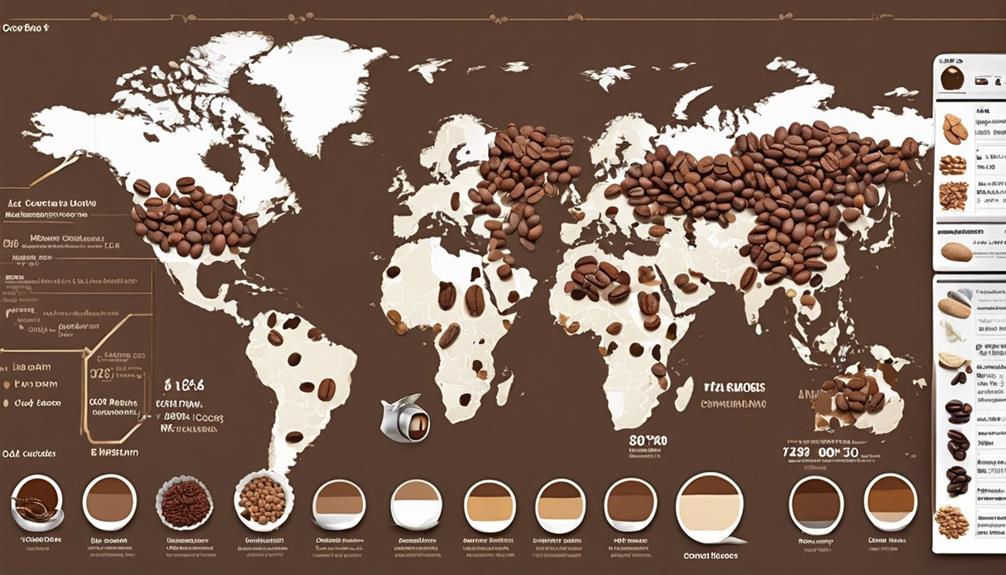
With over 2 billion cups consumed daily, global coffee consumption surpasses many other popular beverages. When comparing coffee and cocoa beans, there are significant differences in global consumption patterns:
- Coffee is a daily staple for millions worldwide, enjoyed for its rich flavors and energizing effects.
- The global demand for coffee continues to rise steadily, with specialty coffees gaining popularity among consumers.
- Cocoa, on the other hand, is mainly used in confectionery and baking, with consumption peaking during holidays and special occasions.
- While both beans are essential commodities in the global market, coffee's widespread consumption outpaces that of cocoa due to its versatility and widespread appeal.
Understanding the global consumption trends of these beans can provide valuable insights into the preferences and habits of consumers worldwide.
Frequently Asked Questions
What Is the Difference Between Cocoa and Coffee Beans?
The difference between cocoa and coffee beans lies in their origins and flavors. Cocoa beans from cacao plants yield chocolate with a bitter taste, while coffee beans from arabica plants offer a deep, earthy flavor when brewed.
How Can You Compare Coffee and Cocoa?
When comparing coffee and cocoa, I find that coffee's bold aroma wakes me up in the morning, while cocoa's rich taste comforts me at night. Each bean has a unique flavor that suits different moments perfectly.
What Are the Similarities Between Cocoa Beans and Coffee Beans?
Both cocoa beans and coffee beans share similarities as stimulants, providing unique flavors and energy boosts. They both require time to grow and undergo similar processing steps. While cocoa has theobromine and coffee has caffeine, both offer antioxidants.
What Is the Difference Between Cocoa Beans and Cocoa Beans?
Well, the main difference between cocoa beans and coffee beans is their origin and use. Cocoa beans come from the cacao plant and are used to make chocolate, while coffee beans come from the coffee plant and are used to make coffee.
How Does the Caffeine Content of Cocoa Beans Compare to Coffee Beans in Terms of Taste and Health Benefits?
When comparing cocoa vs coffee caffeine content, cocoa beans contain significantly less caffeine than coffee beans. However, the taste and health benefits of cocoa can still be appealing to many. Cocoa provides antioxidant properties and can promote heart health, while coffee is known for its energy-boosting effects.
Conclusion
To sum up, coffee beans and cocoa beans may seem similar at first glance, but they've distinct differences in flavor, caffeine content, and processing methods. Understanding these variations can enhance your appreciation for each bean and the products they create.
Whether you're a coffee lover or a chocolate enthusiast, exploring the unique characteristics of these beans can provide a deeper understanding of the world of beverages and confections.

